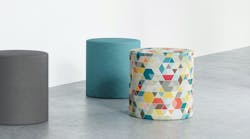Voice your opinion!
Voice your opinion!
There’s a lot you could say about one of Designtex’s newest collections Tilt + Nest. It’s bright and playful, but also subtle. It’s GREENGUARD certified and California Prop 65 compliant, two indicators that this product can meet some of the toughest sustainability criteria.
“But what I think is the coolest thing about this material,” said Designtex principal designer Sara Balderi, “is that it is water-based.”
The collection’s material comprises a water-based polyurethane from fabric company Crypton. Water-based, as Balderi explained it, refers to the fact that Tilt + Nest does not contain any dimethylformamide (DMF), which is a common component in the makeup of polyurethane and often noted as a “chemical of concern,” even though it typically dissipates to low or trace levels through the manufacturing process.
There are none of these solvents in Tilt + Nest to begin with, so “we consider it a very pure composition,” Balderi said.
This innovative engineering of the collection meant that Balderi didn’t have to take any aesthetic concessions while designing.
“I had a blank canvas—there were no limitations,” she said. “Which, for a designer, is a dream scenario. This was really about playing with color.”
Tilt puts that notion on full display. It’s a multicolored, geometric, digitally printed pattern made up of 15 colorways. Balderi said the Designtex team really wanted to fill a range of colors from subtle neutrals to more punchy hues. Nest, on the other hand, is a solid texture laid on top of a subtle organic patterning.
“One colorway in the collection has very bright and bold, more primary colors, and then on the other end there’s a colorway all built on tinted neutrals,” Balderi explained. “So, there’s this range of primary, tertiary and more complex combinations as well. We were also considering the environments this collection would be going in, like healthcare—what are some of the things or trends we’re seeing?”
One of the inherent challenges of bringing this collection to life, because it was a brand-new material to the market, was a longer than normal development cycle. Along with adhering to industry standards, Designtex adheres to its own set of standards, especially for applications in healthcare.
“When looking at products intended for healthcare, there’s definitely a heavy-duty evaluation process that we put them through before bringing to market, because we want to feel completely confident on our end,” Balderi said. “We’re confident [Tilt + Nest] will work not only in a university lounge or hotel lobby, but also perform—or even outperform—in something like an ER setting, your more acute healthcare settings.”
The diverse colorways of the collection make it easy to coordinate with other aspects, materials or colors in a space and help bring a scheme together. But what Balderi said really struck a chord with their customers is that fact that there’s no sacrificing performance for sustainability, and vice versa.
“In the past they could live at two different ends of the spectrum,” she said. “What’s nice about [Tilt + Nest] is we’re able to meet in the middle. It’s a nice time to be designing with these new technologies. There’s also no concessions aesthetically—your product won’t get anywhere if you have amazing performance or sustainable qualities, but it doesn’t look good or doesn’t get people excited or inspired.”
Read Next: Redefining Healthcare Interior Design and Materials in a Post-Pandemic World
